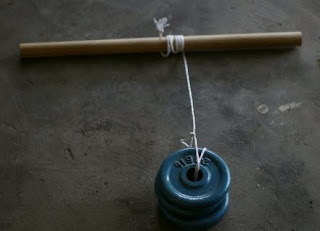DIY Training Equipment #3 - Makiwara

I have made a makeshift makiwara, loosely based on designs garnered from the internet, but also from Mike Clarke's book "Hojo Undo". Compared to some of the makiwara out there, it's quite springy, and compared to others, it's a bit woosy. I like to think of it as "my-first-makiwara", and the intention is, once I've broken myself in to using it, I'll replace it with a stronger one. It is made from a spare mountain ash plank I had lying around. I sawed it into two lengths, one shorter than the other, and dug a hole to put it in. At the base of the hole, I put a large rock just in front of the planks and as I filled it in, I placed another rock about 2/3 of the way up behind the planks. I packed all the dirt down, angling the board a little forward of vertical (about 10 degrees). The idea behind the two planks was to give me a poor-man's way of angling the wood. In a traditional makiwara, it is made of a single piece of tapered wood - ab...


